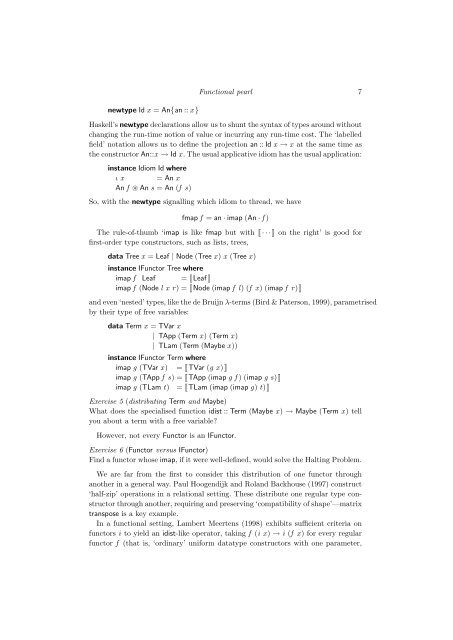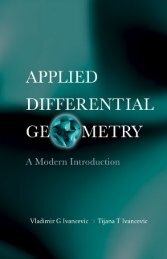Idiom
Idiom
Idiom
Create successful ePaper yourself
Turn your PDF publications into a flip-book with our unique Google optimized e-Paper software.
newtype Id x = An{an :: x }<br />
Functional pearl 7<br />
Haskell’s newtype declarations allow us to shunt the syntax of types around without<br />
changing the run-time notion of value or incurring any run-time cost. The ‘labelled<br />
field’ notation allows us to define the projection an :: Id x → x at the same time as<br />
the constructor An::x → Id x. The usual applicative idiom has the usual application:<br />
instance <strong>Idiom</strong> Id where<br />
ι x = An x<br />
An f ⊛ An s = An (f s)<br />
So, with the newtype signalling which idiom to thread, we have<br />
fmap f = an · imap (An · f )<br />
The rule-of-thumb ‘imap is like fmap but with · · · on the right’ is good for<br />
first-order type constructors, such as lists, trees,<br />
data Tree x = Leaf | Node (Tree x) x (Tree x)<br />
instance IFunctor Tree where<br />
imap f Leaf = Leaf <br />
imap f (Node l x r) = Node (imap f l) (f x) (imap f r)<br />
and even ‘nested’ types, like the de Bruijn λ-terms (Bird & Paterson, 1999), parametrised<br />
by their type of free variables:<br />
data Term x = TVar x<br />
| TApp (Term x) (Term x)<br />
| TLam (Term (Maybe x))<br />
instance IFunctor Term where<br />
imap g (TVar x) = TVar (g x)<br />
imap g (TApp f s) = TApp (imap g f ) (imap g s)<br />
imap g (TLam t) = TLam (imap (imap g) t)<br />
Exercise 5 (distributing Term and Maybe)<br />
What does the specialised function idist :: Term (Maybe x) → Maybe (Term x) tell<br />
you about a term with a free variable?<br />
However, not every Functor is an IFunctor.<br />
Exercise 6 (Functor versus IFunctor)<br />
Find a functor whose imap, if it were well-defined, would solve the Halting Problem.<br />
We are far from the first to consider this distribution of one functor through<br />
another in a general way. Paul Hoogendijk and Roland Backhouse (1997) construct<br />
‘half-zip’ operations in a relational setting. These distribute one regular type constructor<br />
through another, requiring and preserving ‘compatibility of shape’—matrix<br />
transpose is a key example.<br />
In a functional setting, Lambert Meertens (1998) exhibits sufficient criteria on<br />
functors i to yield an idist-like operator, taking f (i x) → i (f x) for every regular<br />
functor f (that is, ‘ordinary’ uniform datatype constructors with one parameter,














